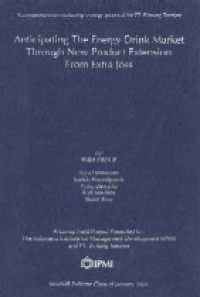
Consumer acceptance towards Neutra Air: a new concept of airfreshener
| Gmd : Text
| Availability :
| 00000008558 | 164 | (GFP) | Available - Ada |
A field project has been conducted to get information on how is consumer acceptance towards new product concept of airfreshener i.e. NEUTRA AIR that was planned to be launched by PT. Reckitt & Colman Indonesia (the Company). Research was done both qualitatively i.e. by holding a focus group discussion, and quantitatively i.e. by conducting Usage and Attitude Survey on 100 respondents. Respondents were divided into four groups, depending on their socio economy class and whether they are user or non-user of airfreshener. There are User A, User B, Non- user A and Non-user B classes.
The airfreshener market was growing at a rate of 20-24% annually in 1995-1997. It was segmented into three different types: aerosol, gel and decorative. The trend of product type shifted from aerosol to decorative. There are several brands of the product, however, only few brands such as Bayfresh, Glade and Haze dominate the market. Each strong brand has its superiority. Bayfresh dominate the aerosol market with more than sixteen variants, while Glade has a strong position in the decorative segment. Haze, the Company's airfreshener, limited its product range only to aerosol and gel. Each product competes in the market by means of offering different product variant (different fragrance), different pricing strategy and product's attributes or claim.
A research on consumer behavior toward the product explores how is the consumer's household daily practices. Specifically their opinion on the subject of house cleanliness, malodor, problematic areas in their house prone to having malodor and how they handle it. Study on the airfreshener product usage gives information on what is the consumer objective of using the product which vary from fragrance the room, eliminate malodor or freshening/convenient. The use the product in the bathroom, bedroom and living room. Several attributes were mentioned by rank of importance; among others are safe for health, eliminate malodor, natural and long lasting fragrance. As the NEUTRA AIR product concept was mainly aimed for eliminating malodor, the result mentioning that this attribute was considered important gives a positive indication. Moreover, from the product's claim, existing producers have not offered the important attributes perceived by consumers yet. Consumers were aware of some attributes such as fragrance, deodorizer, stainless and non-CFC. However, they were not able to associate them with any specific brand. Fruits and flowers are the most preferred fragrance. Consumer chose different product type for different purpose/place e.g. clip-on and gel were mostly chosen for use in the bathroom while spray for the other room.
For brand awareness, Bayfresh (50%) ranked first across the user group followed by Glade (29%). In the non-user group, Glade outperforms Bayfresh as the top of mind brand. From household penetration data, the user group was still low at 10%, which means that a big potential target was in the non-user. Awareness of Haze was 2%, so that it is strongly suggested for the Company to build awareness through more aggressive communication effort to target consumers.
Several alternative solutions in launching the new concept can be put forward. Each alternative has its pros and cons. There are three alternatives: (1) launch NEUTRA AIR- 1, (2) launch NEUTRA AIR-2 and (3) launch NEUTRA AIR-2 as core product AND NEUTRA AIR-l as one of the variant. From these three, alternative (3) was recommended as it sets a high barrier to entry, it serves as relatively easy education for consumer in appreciating new value of eliminating malodor and from production point of view it facilitates achievement of economy of scale. However, the Company still has to alleviate some constraints such as the cannibalization risk, lack of focus in communication and a relatively high investment in logistic and distribution.
Therefore, to support the recommendation, some strategies are suggested to be considered such as: the Company has to carefully design the communication, select the fragrance type, select the product type that is not cannibatizing each other.
Research Location: PT. Reckitt & Colman Indonesia
Supervisor: Hadi Satyagraha, Ph.D
Accepted on December 1997
For IPMI Internal -- Read at library only
| Series Title |
-
|
|---|---|
| Call Number |
164
|
| Publisher Place | Jakarta |
| Collation |
v, 81p.: figs., tabs.; 27cm
|
| Language |
English
|
| ISBN/ISSN |
-
|
| Classification |
-
|
| Media Type |
-
|
|---|---|
| Carrier Type |
-
|
| Edition |
-
|
| Subject(s) | |
| Specific Info |
-
|
| Statement |
-
|
| Content Type |
-
|
No other version available







